An Oil ETF (Exchange Traded Fund) is a type of investment fund that provides exposure to the performance of the oil industry by tracking the prices of oil-related assets, such as crude oil, oil futures contracts, or shares of oil companies. ETFs are traded on stock exchanges like regular stocks, which makes them an accessible and convenient way for investors to gain exposure to the oil market without directly investing in physical oil or individual oil company stocks. Oil ETFs can be structured in various ways. Some ETFs track a specific index, like the price of crude oil or an index of oil company stocks, while others might invest in a diversified portfolio of oil-related assets. By investing in an oil ETF, investors can benefit from the potential growth of the oil industry while also mitigating the risks associated with investing in individual oil companies or holding physical oil. However, it is important to be aware of the risks and fees associated with oil ETFs, as they can vary across different funds. Crude oil ETFs aim to track the price of crude oil. They typically do this by investing in futures contracts. Some of the popular crude oil ETFs include the United States Oil Fund (USO) and the ProShares Ultra Bloomberg Crude Oil (UCO). Oil services ETFs invest in companies that provide services to the oil industry. This can include drilling, exploration, production, and transportation companies. The VanEck Vectors Oil Services ETF (OIH) is one of the largest oil services ETFs. Exploration and production ETFs invest in companies that are involved in the exploration and extraction of oil. These ETFs provide exposure to the upstream segment of the oil industry. The SPDR S&P Oil & Gas Exploration & Production ETF (XOP) is an example of an exploration and production ETF. Integrated oil ETFs invest in companies that are involved in all aspects of the oil industry, from exploration and extraction to refining and selling the finished product. These companies are typically large, multinational corporations. The iShares Global Energy ETF (IXC) is an example of an integrated oil ETF. Futures contracts play a significant role in oil ETFs. A futures contract is an agreement to buy or sell a specific quantity of a commodity, such as oil, at a specified price and future date. Most oil ETFs invest in oil futures contracts as opposed to physical oil. The performance of these ETFs is therefore tied to the performance of the futures contracts they hold. Contango and backwardation are two phenomena that occur in the futures market and can affect the performance of oil ETFs. Contango occurs when the futures price is higher than the spot price. Backwardation, on the other hand, occurs when the futures price is lower than the spot price. These market conditions can impact the roll yield of an ETF, which is the gain or loss incurred when an ETF rolls its futures contracts forward to the next month. Tracking error refers to the discrepancy between the performance of an ETF and the performance of its underlying benchmark or index. In the case of oil ETFs, tracking errors can occur due to factors such as contango, backwardation, and the costs associated with rolling futures contracts forward. Global supply and demand for oil is one of the most significant factors affecting the price of oil ETFs. When demand outstrips supply, oil prices and the value of oil ETFs typically rise. Conversely, when supply exceeds demand, prices tend to fall. Political events, particularly in oil-rich regions, can significantly impact oil prices. Conflicts, sanctions, or regulatory changes can disrupt oil production and supply, causing oil prices and the value of oil ETFs to fluctuate. Oil is a key input in many industries, and demand for oil often increases during periods of economic growth and high industrial production. As such, these factors can influence the price of oil and, by extension, the value of oil ETFs. Since oil is globally traded in U.S. dollars, fluctuations in the value of the dollar can affect oil prices. When the dollar weakens against other currencies, oil becomes cheaper for foreign buyers, potentially increasing demand and pushing up prices. Oil ETFs are traded on major exchanges, just like stocks. This means that investors can buy and sell shares in an oil ETF throughout the trading day at market prices. The ability to quickly enter and exit positions make oil ETFs a highly liquid investment. Oil ETFs provide an easy way to diversify an investment portfolio. Instead of buying shares in a single oil company, an investor can buy an oil ETF and gain exposure to a broad segment of the oil industry or the commodity itself. Oil ETFs provide a way for individual investors to gain exposure to oil without having to trade futures contracts. Trading futures requires a certain level of sophistication and risk tolerance that not all investors possess. Oil ETFs, on the other hand, can be bought and sold like stocks through a brokerage account. The price of oil can be highly volatile, driven by a variety of factors, including geopolitical events, changes in supply and demand, and natural disasters. This volatility can lead to significant price swings in oil ETFs. Changes in government regulations can impact the oil industry. For example, regulations related to environmental concerns, drilling rights, and tax incentives can all affect the profitability of oil companies and, in turn, the value of oil ETFs. The value of oil ETFs that invest directly in oil or in futures contracts is directly tied to the price of oil. If the price of oil falls, the value of these ETFs will also fall. Furthermore, the use of futures contracts can introduce additional risks related to the futures market, such as contango and backwardation. Before investing in an oil ETF, it's important to conduct thorough research and due diligence. This includes understanding the various types of oil ETFs, their investment strategies, and the risks involved. Choosing the right oil ETF depends on an investor's financial goals, risk tolerance, and investment horizon. Some may prefer ETFs that offer broad exposure to the oil industry, while others may prefer ETFs that focus on specific segments of the industry. Once an investor has chosen an oil ETF, they can purchase it through a brokerage account. The process is similar to buying a stock: the investor places an order for the ETF, and once the order is filled, the ETF shares are added to their portfolio. Investing in oil ETFs can provide investors with exposure to the performance of the oil industry through a range of different strategies. Choosing the appropriate strategy will depend on an individual's investment goals, risk tolerance, and market outlook. Below, we explore several common strategies for investing in oil ETFs. A buy-and-hold strategy involves purchasing an oil ETF and holding it for an extended period, typically with the expectation that the value of the investment will increase over time. This approach can be suitable for long-term investors who believe in the growth potential of the oil industry and are not concerned with short-term fluctuations in oil prices or the broader market. Tactical asset allocation is a more active approach to investing in oil ETFs, which involves adjusting the weight of oil exposure within a portfolio based on market conditions, economic factors, or personal investment preferences. Investors who use this strategy may increase their allocation to oil ETFs when they anticipate higher oil prices or positive trends in the industry and decrease their exposure when they foresee potential declines or market instability. Oil ETFs can also be used as hedging instruments to manage the risk associated with other investments in a portfolio. For example, an investor who holds stocks in oil-sensitive industries, such as airlines or transportation companies, might invest in an inverse oil ETF to offset potential losses that could result from a decline in oil prices. Similarly, investors with significant exposure to the energy sector can use oil ETFs to diversify their holdings and mitigate the risk associated with individual oil companies or industry-specific events. Investors with a short-term outlook may use oil ETFs for trading purposes, taking advantage of price movements in the oil market. This strategy typically involves buying and selling oil ETFs frequently, based on technical analysis or market news, to capitalize on short-term fluctuations in oil prices. However, short-term trading can be riskier than long-term investing and may result in higher transaction costs due to frequent trading. The tax treatment of commodity ETFs, including oil ETFs, can be complex. Unlike traditional equity ETFs, commodity ETFs may be structured as limited partnerships, which can have different tax implications. Investors should consult with a tax advisor before investing. Many commodity ETFs issue Schedule K-1 tax forms to their investors. These forms report an investor's share of the ETF's income, deductions, and credits for the year. While K-1 forms can be more complex than the standard 1099 forms, they are a critical part of the tax reporting process for investors in these ETFs. One alternative to oil ETFs is investing directly in energy stocks. This could involve buying shares in oil companies or companies in related industries, such as natural gas or renewables. Mutual funds and index funds that focus on the energy sector can offer similar exposure to oil and related industries as oil ETFs. These funds, however, may have different liquidity and management fee structures compared to ETFs. Investors with a high-risk tolerance and understanding of the futures market might consider trading oil futures contracts as an alternative to investing in oil ETFs. This strategy, however, involves a higher level of risk and complexity. Oil ETFs provide an accessible and diverse route for investors seeking exposure to the oil industry through tracking oil-related assets like crude oil prices, oil futures contracts, or oil company stocks. They offer benefits like liquidity, diversification, and accessibility while also bearing risks, including market volatility, regulatory changes, and commodity price risks. Oil ETFs are influenced by factors such as global oil supply and demand, political events, economic growth, and currency fluctuations. Investment strategies may range from a long-term buy-and-hold approach to short-term trading or hedging against risks in other investments. However, understanding the complex tax implications associated with oil ETFs is critical. Alternatives to oil ETFs include investing in energy stocks, mutual funds, index funds, or directly in oil futures contracts. Therefore, thorough research and a clear understanding of the risks involved are essential before investing in oil ETFs.What Are Oil ETFs?
Different Types of Oil ETFs
Crude Oil ETFs
Oil Services ETFs
Exploration and Production ETFs
Integrated Oil ETFs
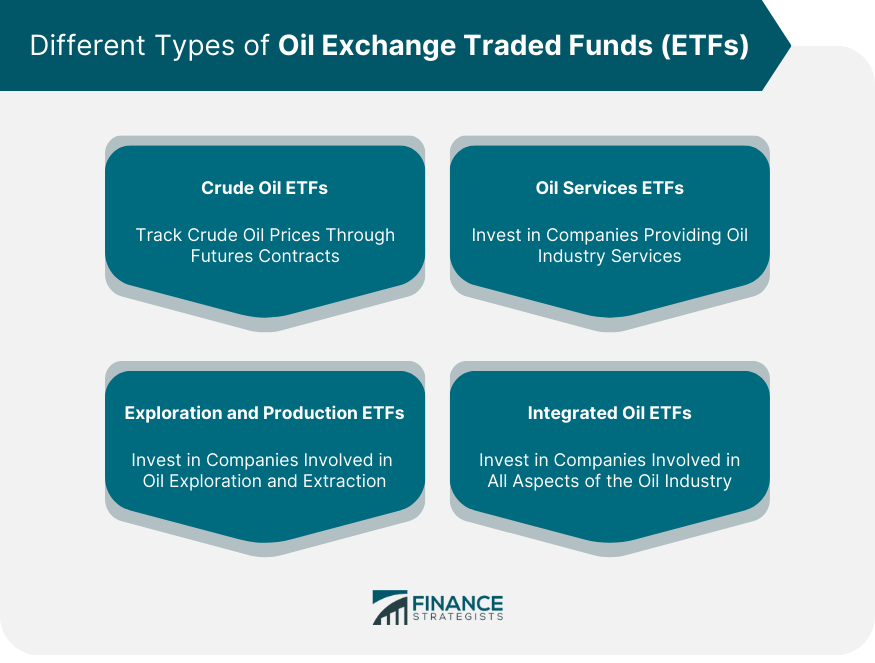
How Oil ETFs Work
Role of Futures Contracts in Oil ETFs
Concept of Contango and Backwardation
Tracking Errors in Oil ETFs
Factors Influencing the Price of Oil ETFs
Global Oil Supply and Demand
Political Events and Instability
Economic Growth and Industrial Production
Currency Fluctuations
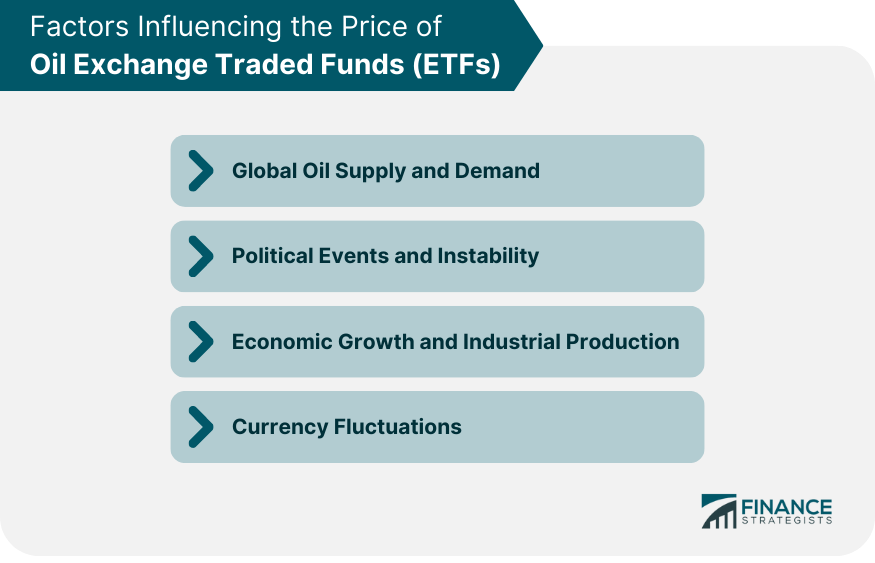
Benefits of Oil ETFs
Liquidity
Diversification
Accessibility
Risks Associated With Oil ETFs
Market Volatility
Regulatory Risks
Commodity Price Risks
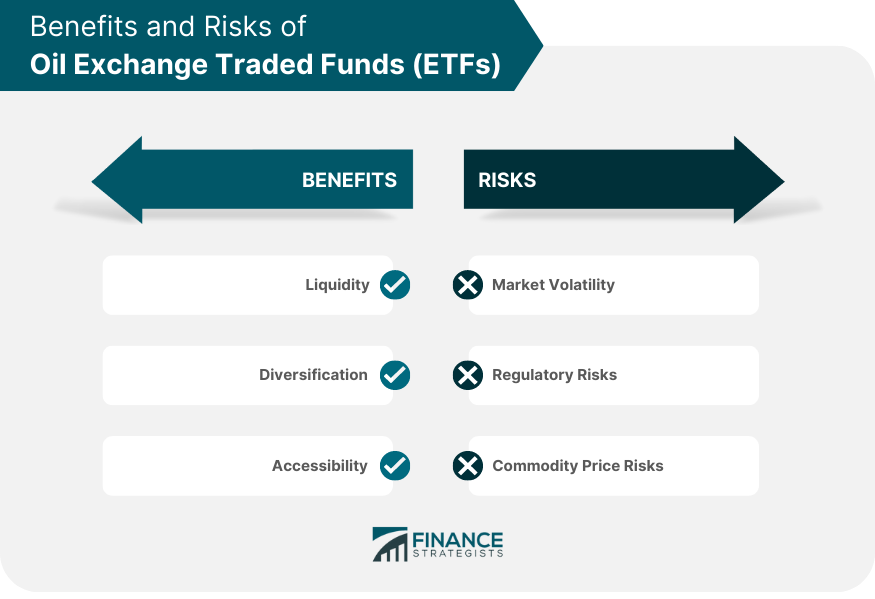
How to Invest in Oil ETFs
Research and Due Diligence
Choose the Right Oil ETF
Purchase Oil ETFs through a Brokerage Account
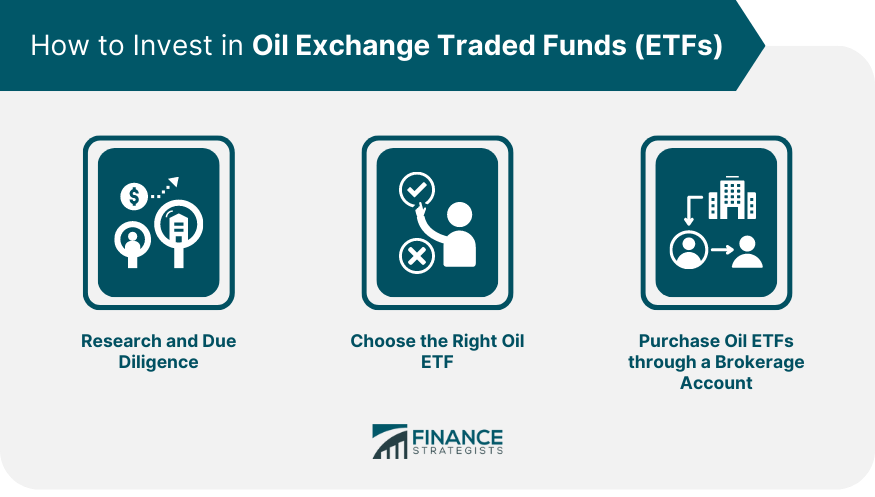
Strategies for Investing in Oil ETFs
Buy-And-Hold Strategy
Tactical Asset Allocation
Hedging Instruments
Short-Term Trading
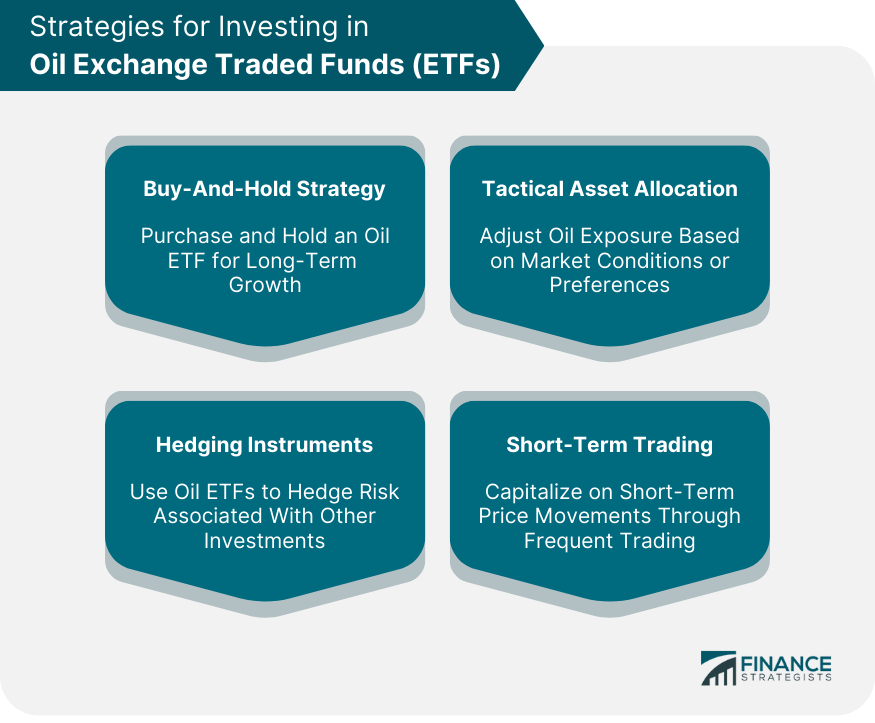
Tax Implications of Investing in Oil ETFs
Tax Treatment of Commodity ETFs
Understanding K-1 Tax Forms
Alternatives to Oil ETFs
Energy Stocks
Mutual Funds and Index Funds
Futures Contracts
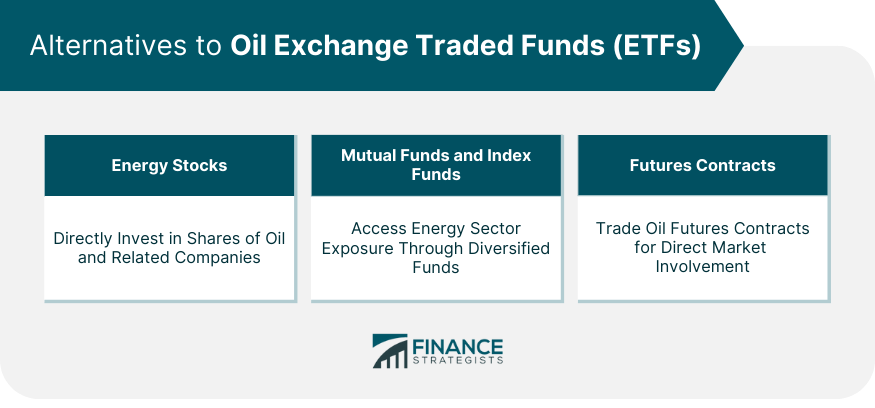
Final Thoughts
Oil ETF FAQs
An oil ETF is an exchange-traded fund that invests in oil-based assets. It provides investors exposure to oil commodities without the need for a futures account.
Oil ETFs provide liquidity, diversification, and accessibility. They allow investors to gain exposure to the oil market without having to buy futures contracts or physical oil.
Risks associated with investing in oil ETFs include market volatility, regulatory changes, and commodity price risks. The price of oil can be influenced by a variety of factors, leading to potential price swings in oil ETFs.
Most oil ETFs work by investing in futures contracts for oil. As such, the price of an oil ETF can be influenced by the spot price of oil, the futures market for oil, or the earnings of the companies included in the ETF.
Alternatives to oil ETFs include energy stocks, mutual funds, and index funds focused on the energy sector and futures contracts.
True Tamplin is a published author, public speaker, CEO of UpDigital, and founder of Finance Strategists.
True is a Certified Educator in Personal Finance (CEPF®), author of The Handy Financial Ratios Guide, a member of the Society for Advancing Business Editing and Writing, contributes to his financial education site, Finance Strategists, and has spoken to various financial communities such as the CFA Institute, as well as university students like his Alma mater, Biola University, where he received a bachelor of science in business and data analytics.
To learn more about True, visit his personal website or view his author profiles on Amazon, Nasdaq and Forbes.











